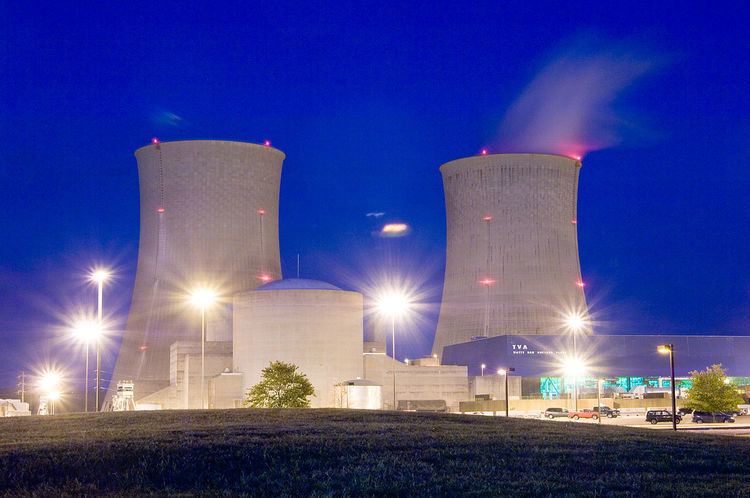Country United States Construction began 1973 Phone +1 865-632-2101 Cooling source Tennessee River | Status Operational Construction cost More than $12 billion Reactor type Pressurized water reactor Cooling towers 2 | |
 | ||
Location Rhea County, near Spring City, Tennessee Commission date Unit 1: May 27, 1996
Unit 2: 3 October, 2016 Address 6868 Watts Bar Highway, Spring City, TN 37381, USA Similar Sequoyah Nuclear Generatin, Browns Ferry Nuclear P, Watts Bar Dam, Bellefonte Nuclear Generatin, Comanche Peak Nuclear P | ||
The Watts Bar Nuclear Power Plant is a Tennessee Valley Authority (TVA) nuclear reactor pair used for electric power generation. It is located on a 1,770-acre (7.2 km²) site in Rhea County, Tennessee, near Spring City, between the cities of Chattanooga and Knoxville. Watts Bar supplies enough electricity for about 1,200,000 households in the Tennessee Valley.
Contents
The plant, construction of which began in 1973, has two Westinghouse pressurized water reactor units: Unit 1, completed in 1996, and Unit 2, completed in 2015. Unit 1 has a winter net dependable generating capacity of 1,167 megawatts. Unit 2 has a capacity of 1,165 megawatts. Unit 2 is the most recent civilian reactor to come on-line in the United States and the first new reactor to enter service in the United States after a 20 year hiatus.
Unit 2
Unit 2 was 80% complete when construction on both units was stopped in the 1980s due in part to a projected decrease in power demand. In 2007, the Tennessee Valley Authority (TVA) Board approved completion of Unit 2 on August 1, and construction resumed on October 15. The project was expected to cost $2.5 billion, and employ around 2,300 contractor workers. Once finished, it will create an estimated 250 permanent jobs.
A year after the 2011 Tōhoku earthquake and tsunami and subsequent Fukushima Daiichi nuclear disaster, the Nuclear Regulatory Commission (NRC) issued 9 orders to improve safety at domestic plants. Two applied to Watts Bar Unit 2 and required design modifications: "Mitigation Strategies Order" and "Spent Fuel Pool Instrumentation Order". In February 2012, TVA said the design modifications to Watts Bar 2 were partially responsible for the project running over budget and behind schedule. The second unit cost a total of US$4,700,000,000 bringing the total cost of the plant to more than US$12,000,000,000.
TVA declared construction substantially complete in August 2015 and requested that NRC staff proceed with the final licensing review; on October 22, the NRC approved a forty-year operating license for Unit 2, marking the formal end of construction and allowing for the installation of nuclear fuel and subsequent testing. On December 15, 2015, TVA announced that the reactor was fully loaded with fuel and ready for criticality and power ascension tests. On May 23, 2016, initial criticality was achieved. As of August 31, 2016, a transformer fire had delayed the start of commercial operation past the late summer goal. Commercial operation started in October 2016, once the affected transformer was replaced, operators completed the inspection on the switchyard affected equipment and the final full power testing was completed. On October 19, 2016 the Watts Bar 2 was the first United States reactor to enter commercial operation since 1996. It is likely the last built Generation II reactor.
Tritium production
The NRC operating license for Watts Bar was modified in September 2002 to allow TVA to irradiate tritium-producing burnable absorber rods at Watts Bar to produce tritium for the U.S. Department of Energy's (DOE's) National Nuclear Security Administration. The Watts Bar license amendment currently permits TVA to install up to 240 tritium-producing rods in Watts Bar Unit 1. Planned future license amendments would allow TVA to irradiate up to approximately 2,000 tritium-producing rods in the Watts Bar reactor.
TVA began irradiating tritium-producing rods at Watts Bar Unit 1 in the fall of 2003. TVA removed these rods from the reactor in the spring of 2005. DOE successfully shipped them to its tritium-extraction facility at Savannah River Site in South Carolina. DOE reimburses TVA for the cost of providing the irradiation services, and also pays TVA a fee for each tritium-producing rod that is irradiated.
Surrounding population
The NRC defines two emergency planning zones around nuclear power plants: a plume exposure pathway zone with a radius of 10 miles (16 km), concerned primarily with exposure to, and inhalation of, airborne radioactive contamination, and an ingestion pathway zone of about 50 miles (80 km), concerned primarily with ingestion of food and liquid contaminated by radioactivity.
The 2010 U.S. population within 10 miles (16 km) of Watts Bar was 18,452, an increase of 4.1 percent in a decade, according to an analysis of U.S. Census data for msnbc.com. The 2010 U.S. population within 50 miles (80 km) was 1,186,648, an increase of 12.8 percent since 2000. The city center of Oak Ridge is located 37 miles (60 km) from the station.
Seismic risk
The Nuclear Regulatory Commission's estimate of the risk each year of an earthquake intense enough to cause core damage to the reactor at Watts Bar was 1 in 27,778, according to an NRC study published in August 2010.
